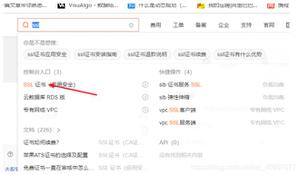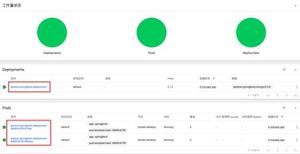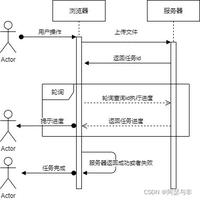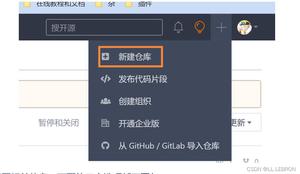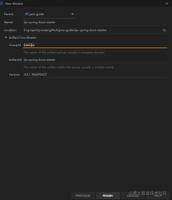springboot初探——启动流程

其他的我们可以先不管,先来看一眼springboot的main方法
@SpringBootApplicationpublic class DemoApplication {
public static void main(String[] args) {
SpringApplication.run(DemoApplication.class, args);
}
}
这里做了什么?一个注解,一个SpringApplication的静态方法,这两步完成了springboot项目启动的所有步骤。
现在我们来研究到底做了些什么。
注解先不去管它,顺着SpringApplication#run这个方法往下走
public static ConfigurableApplicationContext run(Class<?> primarySource, String... args) { return run(new Class<?>[] { primarySource }, args);
}
public static ConfigurableApplicationContext run(Class<?>[] primarySources, String[] args) {
return new SpringApplication(primarySources).run(args);
}
可以看到这两个静态方法,实际上做的事又是实例化SpringApplication对象,并调用run方法。所以这时候我们还可以把启动类写成这样
@SpringBootApplicationpublic class DemoApplication {
public static void main(String[] args) {
// SpringApplication.run(DemoApplication.class, args);
SpringApplication springApplication = new SpringApplication(DemoApplication.class);
springApplication.run(args);
}
}
我们可以先拿到一个SpringApplication的实例,然后再通过实例调用run方法,继续看下边的操作。
public SpringApplication(Class<?>... primarySources) { this(null, primarySources);
}
public SpringApplication(ResourceLoader resourceLoader, Class<?>... primarySources) {
this.resourceLoader = resourceLoader;
Assert.notNull(primarySources, "PrimarySources must not be null");
this.primarySources = new LinkedHashSet<>(Arrays.asList(primarySources));
this.webApplicationType = WebApplicationType.deduceFromClasspath();
setInitializers((Collection) getSpringFactoriesInstances(ApplicationContextInitializer.class));
setListeners((Collection) getSpringFactoriesInstances(ApplicationListener.class));
this.mainApplicationClass = deduceMainApplicationClass();
}
这里可以看到,在实例化SpringApplication对象时,做了好多操作:
- 设置resourceLoader,加载资源用的,我们可以自己实现,加载外部资源等
- primarySources设置bean的主要加载来源
- webApplicationType确定启动的方式,WebApplicationType.deduceFromClasspath()这个方法要注意一下,WebApplicationType是个枚举类,通过判断当前路径下有没有某个类来确定启动方式的,目前支持三种方式(NONE,SERVLET,REACTIVE)
static WebApplicationType deduceFromClasspath() { if (ClassUtils.isPresent(WEBFLUX_INDICATOR_CLASS, null) && !ClassUtils.isPresent(WEBMVC_INDICATOR_CLASS, null)
&& !ClassUtils.isPresent(JERSEY_INDICATOR_CLASS, null)) {
return WebApplicationType.REACTIVE;
}
for (String className : SERVLET_INDICATOR_CLASSES) {
if (!ClassUtils.isPresent(className, null)) {
return WebApplicationType.NONE;
}
}
return WebApplicationType.SERVLET;
}
- setInitializers((Collection)getSpringFactoriesInstances(ApplicationContextInitializer.class))是加载spring启动需的上下文
- 设置监听
- 设置启动主类
这里有一个4/5/6步有一个技术点,稍后再详细说
经过这几步以后,就加载完启动一个sping应用所需的资源!
接下来就是run方法了,先贴上代码,乍一看,好长的代码,这都是干了啥啊。
/** * 运行Spring应用程序,创建并刷新一个新的ApplicationContext。
* @param args args应用程序参数(通常从Java主方法传递)
* @return a running {@link ApplicationContext}
*/
public ConfigurableApplicationContext run(String... args) {
StopWatch stopWatch = new StopWatch();
stopWatch.start();
ConfigurableApplicationContext context = null;
Collection<SpringBootExceptionReporter> exceptionReporters = new ArrayList<>();
configureHeadlessProperty();
SpringApplicationRunListeners listeners = getRunListeners(args);
listeners.starting();
try {
ApplicationArguments applicationArguments = new DefaultApplicationArguments(args);
ConfigurableEnvironment environment = prepareEnvironment(listeners, applicationArguments);
configureIgnoreBeanInfo(environment);
Banner printedBanner = printBanner(environment);
context = createApplicationContext();
exceptionReporters = getSpringFactoriesInstances(SpringBootExceptionReporter.class,
new Class[] { ConfigurableApplicationContext.class }, context);
prepareContext(context, environment, listeners, applicationArguments, printedBanner);
refreshContext(context);
afterRefresh(context, applicationArguments);
stopWatch.stop();
if (this.logStartupInfo) {
new StartupInfoLogger(this.mainApplicationClass).logStarted(getApplicationLog(), stopWatch);
}
listeners.started(context);
callRunners(context, applicationArguments);
}
catch (Throwable ex) {
handleRunFailure(context, ex, exceptionReporters, listeners);
throw new IllegalStateException(ex);
}
try {
listeners.running(context);
}
catch (Throwable ex) {
handleRunFailure(context, ex, exceptionReporters, null);
throw new IllegalStateException(ex);
}
return context;
}
未完待续
以上是 springboot初探——启动流程 的全部内容, 来源链接: utcz.com/z/512878.html


